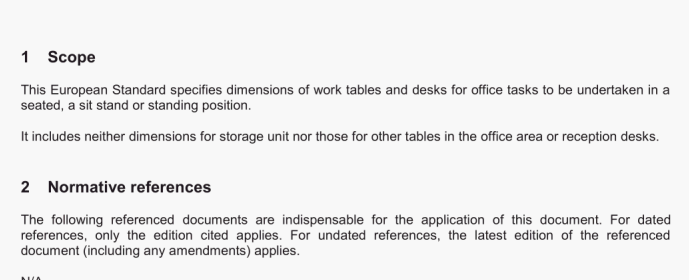BS EN 527-1:2011 Office furniture一Work tables and desks Part 1: Dimensions

BS EN 527-1:2011 pdf free.Office furniture一Work tables and desks Part 1: Dimensions.
This European Standard specifies dimensions of work tables and desks for office tasks to be undertaken in a seated, a sit stand or standing position.
It includes neither dimensions for storage unit nor those for other tables in the office area or reception desks.
2 Normative references
The following referenced documents are indispensable for the application of this document. For dated references, only the edition cited applies. For undated references, the latest edition of the referenced document (including any amendments) applies.
N/A
3 1 Terms and definitions
For the purposes of this document, the fllowing terms and definitions apply.
height of the work surface vertical dimension measured from the floor to the top of the 3.2work surface at the edge closest to the user
work table/desk Type A
height adjustable; the height can be changed by the user during use
3.3 work table/desk Type B
height selectable; the height can be adapted to the user at installation
3.4 work table/desk Type C
fixed height
3.5 work table/desk Type D
limited height selectable or adjustable
3.6 sit-stand work table/desk
height adjustable allowing different work positions from seated to standing
3.7 desk top thickness
thickness of the work surface and all protruding parts or elements of the work table/desk within the width and depth of the legroom
3.8 evelling device
leg component designed to allow the work surface to be set horizontal
3.9 desk top depth
depth of working surface including any extension elements on the same plane
4 Dimensions
4.1 Measurement procedure
Position the work table,’desk on a flat horizontal and rigid Iloor surface, with levelling oevicets tuuly ciosei.
Inclinable desk top work surfaces shall be set to the horizontal or as near to the horizontal as possible.
Before commencing measurement procedure, it shall be determined whether the table/desk is for sitting, standing or siUstand use.
The minimum and maximum height of work surface shall be measured at the front edge (see Figure 1) and the adjustment range shall be recorded. For height selectable work tables/desks type B and 0 the minimum height increments shall also be recorded.
The legroom depth shall be measured at the working position and with the rear edge of the work tableidesk placed against a vertical wall.
Figure 1 shows the legroom for all work surfaces which have straight front edges at least all along the width, W, see Table 1. In these cases, the legroom shall be rectangular with dimensions as specified in Table 1.
Figure 2 shows the legroom for all work surfaces with non-straight front edges. In these cases, the legroom shall be curved with dimensions as specified in Table 1.
4.2 Requirements
The dimensions of tables/desks shall be as specified in Table 1.
General ergonomic principles and explanations to Table I
A.1 General
The functional dimensions of work tables/desks are shown in Table 1. There are four types of desks, A, B, C and D, based on their height adjustability/selectability. The dimensional requirements vary depending on how they are used i.e. whether the users are sitting or standing or can vary their posture from sitting to standing (and anything in between).
The legroom clearance height is determined by the maximum desk top thicknesses t1 at the front edge and t2 at 500 mm from the front edge. The reason for this is to make the measurement process simpler. The maximum desk top thickness has been calculated by subtracting the legroom height requirement from height of the work surface of a fixed height desk. The work tables/desks complying with the Type A and B height of the work surface and the maximum desk top thickness requirements will accommodate the 95”’ percentile European male.
The minimum foot clearance height is specified to allow a clearance under any part of the rear of the work surfaceldesk such as a modesty panel so that users can place their feet on the floor without hitting any part of the desk. For standing work tables/desks only, there is an additional requirement for the minimum foot clearance depth so that users standing In front of the table/desk can work without hitting any obstruction under the work table/desk.
The minimum legroom depth and width for sitting and sitistand work tables/desks is shown in Figure 2. For these work tables/desks, only the legroom depth is specified at knee height and at floor level.This should be deeper than the depth at knee height in order to allow the users to stretch their legs forward at angle of 30 degrees between their lower leg and the vertical and without their feet hitting any part of the work table/desk at the floor level.
The minimum desk top depth (800 mm and 600 mm in some situations) can be different from the required minimum legroom depth. The minimum desk top depth is based on the comfortable eye to monitor distance which should be between 450 mm to 750 mm as specified in A.2.12 of EN ISO 9241-5:1999.
The minimum legroom width for sitting applications (i.e. the gap between the legs or any part or component of the work table/desk at the sides) is specified sufficiently large to allow users to rotate their chairs rather than twist their spines when reaching sideways. The minimum legroom width for standing applications is based on the distance between the outsides of users legs when standing with their legs slightly apart.
The dimensions specified in Table 1 are based upon the following anthropometric data for sitting and standing work taking limitations in technology into account. Body dimensions shown in Table A.1 for the European populations are taken from PeopleSize 2008, by Open Ergonomics.BS EN 527-1 pdf download.BS EN 527-1:2011 Office furniture一Work tables and desks Part 1: Dimensions